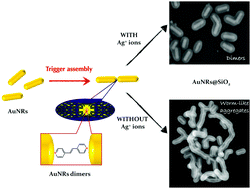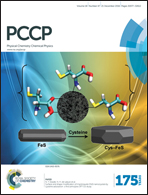Highly stable silica-coated gold nanorods dimers for solution-based SERS†
Abstract
The controlled assembly of anisotropic plasmonic nanoparticles (NPs) into highly SERS-active substrates remains particularly challenging for the production of long-term stable NP assemblies in suspension. In this work, we report a simple and efficient strategy to assemble gold nanorods (AuNRs) into dimers. The pH-dependent assembly was triggered using the bifunctional molecular linker BPE (1,2-bis(4-pyridyl)ethylene) and quenched with silver nitrate. The resulting AuNR dimers were encapsulated in mesoporous silica shell and proved to be stable in water for at least 5 months. Taking advantage of the large Raman scattering cross-section of the linker BPE, we conducted a detailed study of the enhancement ability of these NR dimers using solution-based surface enhanced Raman scattering (SERS). Both experimental (SERS) and theoretical (discrete dipole approximation) studies of the near-field characteristics revealed a two-orders of magnitude increase of the SERS enhancement factor for the dimers as compared to isolated AuNRs. Besides thermal and colloidal stability, mesoporous silica coating of AuNRs imparts other notable advantages due to its porosity and biocompatibility, which make these core–shell plasmonic platforms promising for future bio-applications.


 Please wait while we load your content...
Please wait while we load your content...